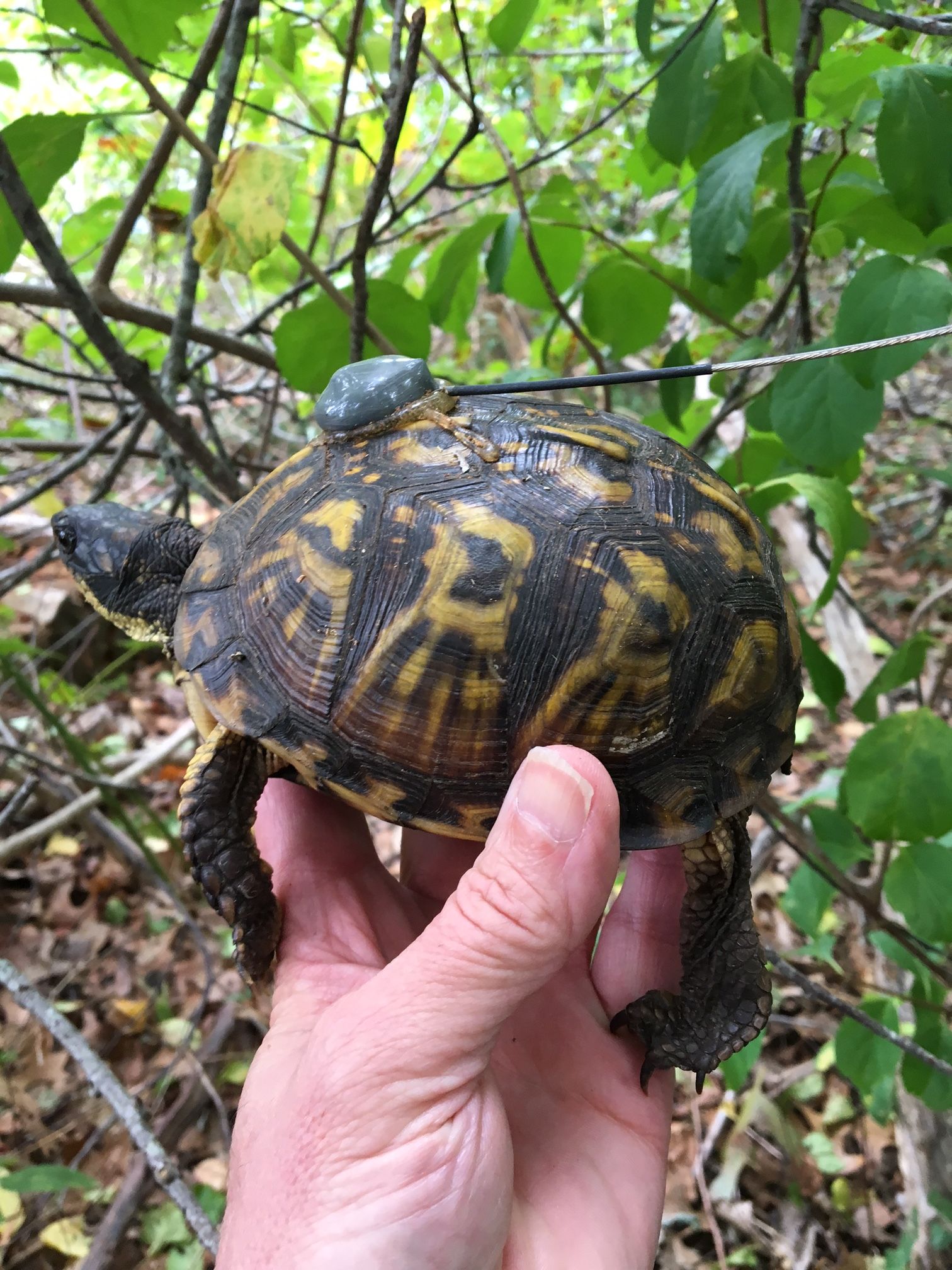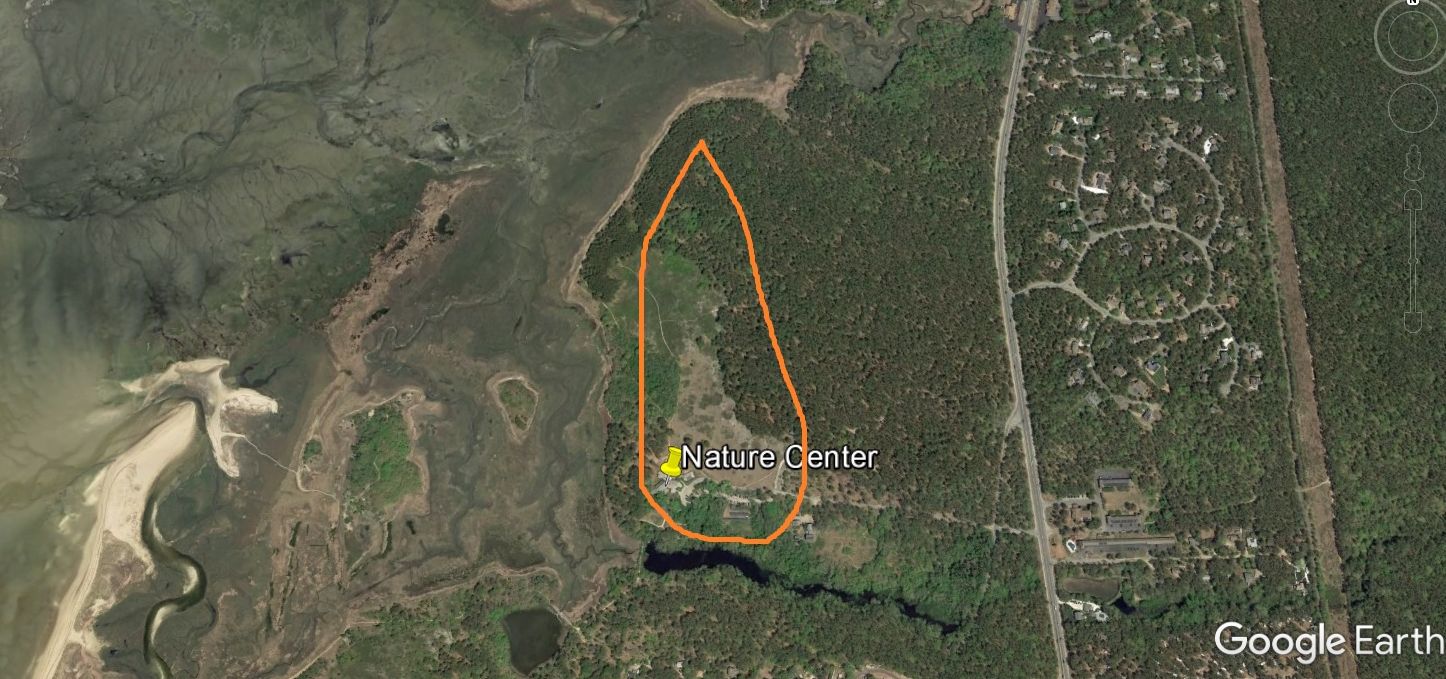Wellfleet Bay is blessed with a healthy, replicating population of Eastern Box Turtles (Terrapene carolina carolina), a species of Special Concern in Massachusetts. In the early 1980’s, sanctuary director Bob Prescott began a mark and recapture study designed to determine our population’s size and monitor its movements. He wanted to learn how many of these land turtles actually live here, what their home ranges are, and to record their patterns of habitat use.
Over the years, with the help of many volunteers, we have accumulated data on nearly 400 turtles, many of which have moved on or passed away. Our resident sanctuary population is now estimated at about 150 adult turtles, some of which may be approaching 100 years old!

This turtle was first marked in 1989 when it was estimated to be at least 30 years old. It was seen again this past summer, so it’s very likely more than 60 years old.
One aspect of the study that has never been fully explored is following one particular turtle throughout an entire season and plotting its movements from emergence in the spring to brumation (reptile hibernation) in the fall. We’ve had radio telemetry equipment for years and we have used it to track box turtles, but no one has tracked one turtle consistently all year.
This season we were able to purchase a new broad band receiver and six Holohil brand radio transmitters. I suggested to Bob that with our new equipment, this could be an ideal opportunity to track some turtles through the season. He agreed and we chose three study turtles to watch very closely.

Tim O’Brien in Spring 2015 using an older aerial antenna receiver to locate turtles fitted with transmitters at the sanctuary.
Female turtles are key to population stability and typically have smaller home ranges than males so we tagged two young females and an older male after they emerged from brumation in May. Our goal was to plot their location with a GPS at least once a week. Box turtles often exhibit high site fidelity and in some cases live out their entire lives in an area no larger than a football field. Others will wander, but will often return to a familiar site to brumate. Ranges can shift according to habitat suitability and food sources.
Of our three study turtles, two initially moved 500 feet and settled in for what would prove to be a hot and very dry summer. But the third turtle, number 709, a fifteen year old female, began an unexpected circumnavigation of the property.

Box Turtle 709 with her radio transmitter attached. (photo by Tim O’Brien)
We first found and marked number 709 at the edge of the woods and the heath field at the top of the Bay View Trail. In the heat of the summer she traveled south across the heath field to Silver Spring, behind the solar array in the parking area, where she remained for several weeks. She then moved west towards the salt marsh and past the other solar array across from the whale bones. Then she paralleled the lower portion of the Bay View Trail before heading back across the heath field to within 100 feet of where she was originally found and marked! If you plot her trip it looks like a big loop.

Turtle 709’s summer wanderings. Hardly a record but a good hike!
A rough estimate of the length of this turtle’s travels (with the help of Google Earth) is 3600 feet, roughly seven-tenths of a mile! This is based on straight line measurements plotted from weekly GPS points, so the total length of her travel was likely more. Although a seasonal loop of this length is far from record setting (a Maryland turtle logged nearly 2 miles a few summers ago), it is much more than what I would call a typical seasonal movement. What is really interesting is that she started and ended her trek at almost the same point where she spends her winters. This is what we’d call a prime example of high brumation site fidelity!

Turtle 709 cozy in her overwintering spot. (photo by Tim O’Brien)
Of course, it’s possible 709 had some help along the way—a person or even a coyote could have moved her at some point. But her seasonal course shows that she ended up very close to where she started. This illustrates the value of systematic tracking and I’m looking forward to following other box turtles next season.
This post was contributed by Wellfleet Bay citizen scientist Tim O’Brien. Tim is a lifelong observer and fan of the Eastern Box Turtle. He and his wife Kim Novino are also dedicated rescuers of cold-stunned sea turtles.


Beautiful beautiful beautiful!!!
Looking at the photo of her overwintering site, it looks as if she could be stepped on by a human. Or us she off the trail and unlikely to be harmed in that way?
Hi, Roz– She’s nicely tucked away in a spot that’s well off the trail that only Tom O’Brien knows about. And it’s not easy to find brumation sites. This turtle had a radio tag on her; otherwise, I doubt even Tim would have discovered her.
Nice job Tim!